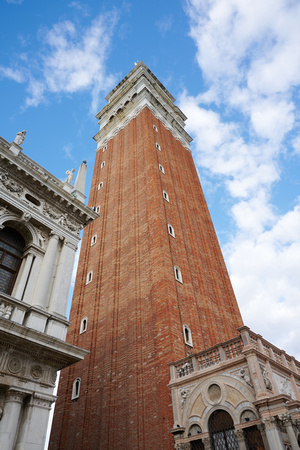the campanile was initially intended as a
watchtower to sight approaching ships and protect the entry to the city. It also served as a landmark to guide Venetian ships safely into harbour. Construction began in the early tenth century and continued sporadically over time as the tower was slowly raised in height. A
belfry and a
spire were first added in the twelfth century. In the fourteenth century the spire was
gilded, making the tower visible to distant ships in the
Adriatic. The campanile reached its full height in 1514 when the belfry and spire were completely rebuilt on the basis of an earlier
Renaissance design by
Giorgio Spavento. Historically, the bells served to regulate the civic and religious life of Venice, marking the beginning, pauses, and end of the work day; the convocation of government assemblies; and public executions.
The campanile stands alone in the square, near the front of St Mark's Basilica. It has a simple form, recalling its early defensive function, the bulk of which is a square brick shaft with
lesenes, 12 metres (39 ft) wide on each side and 50 metres (160 ft) tall.
[3] The belfry is topped by an
attic with effigies of the
Lion of St Mark and
allegorical figures of Venice as
Justice. The tower is capped by a pyramidal spire at the top of which there is a golden
weather vane in the form of the
archangel Gabriel


